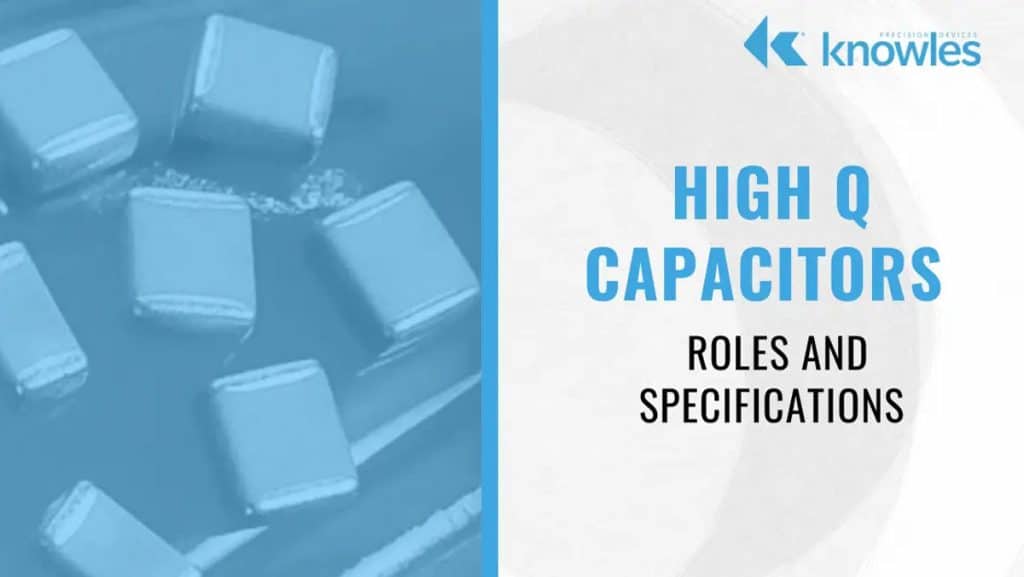This article based on Knowles Precision Devices blog explains high Q ceramic capacitors role, specifications and its applications.
Q factor, or quality factor, is an electrical term used to describe the ratio of energy stored to energy dissipated in a capacitor at a certain frequency (you can learn more about the different components of Q factor and ways to define it here).
In other words, Q factor tells us how good a capacitor is at its job at a certain frequency. A high Q value indicates low energy loss during operation, making these capacitors a good fit for applications requiring low power dissipation and high stability.
The Importance of High Q Capacitors in Electronic Circuits
High Q capacitors are crucial components for various electronic circuits and systems due to their ability to minimize energy losses and maintain a high degree of performance. A High Q capacitor can offer the following characteristics:
- Low Energy Loss – In many applications, minimizing energy loss is crucial to maintain system performance and efficiency. High Q capacitors exhibit lower energy losses in the form of heat or electromagnetic radiation, which is beneficial in high-frequency or high-power applications.
- Well-Defined Frequency Response – High Q capacitors have a narrow bandwidth and a well-defined resonant frequency. This characteristic makes them suitable for applications like filters and oscillators, where sharp frequency response and stability are required.
- Low Equivalent Series Resistance (ESR) – High Q capacitors have a low ESR, which is the resistive component of a capacitor’s impedance. Low ESR results in lower power dissipation, better thermal stability, and better overall performance in high-frequency applications.
- Low Phase Noise – High Q capacitors contribute to lower phase noise in circuits, which is essential for maintaining signal integrity and reducing noise-related issues in communication systems, radar, and other sensitive applications.
It is also important to note that the Q of a capacitor can be managed by carefully choosing the materials and construction of the capacitor. This is because multilayer ceramic capacitors (MLCCs) are made up of alternating layers of ceramic dielectric material and metal electrodes and compressed to form a compact, high-capacitance device.
The Many Jobs High Q Capacitors Perform
As a result of the characteristics described above, high Q MLCCs are widely used in a variety of applications including the following:
- RF and Microwave Circuits – Used for their low loss and high stability in filters, impedance matching networks, and resonant circuits. These components are essential for maintaining signal integrity, minimizing energy losses, and achieving optimal performance.
- Wireless Communication Devices – Used in smartphones, tablets, and Internet of Things (IoT) devices because of their excellent performance in high-frequency circuits and their small form factor.
- Telecommunication Systems – Used for filtering, impedance matching, and noise reduction to ensure optimal signal transmission and reception.
- Oscillators and Timing Circuits – Crucial components for providing stability and reduced phase noise in these devices.
- Medical Equipment and Scientific Instrumentation – Used in medical devices like MRI machines, ultrasonic equipment, and implantable devices where high reliability and low power loss are essential.
- Aerospace and Defense Applications – Used in radar systems, satellite communication devices, and avionics due to their stable performance in extreme environmental conditions and high-frequency operations.
- Antenna Systems – Used to match impedance, minimize energy loss, and improve radiation efficiency.
- Power Electronics – Used in power electronics applications like switch-mode power supplies and power factor correction circuits to minimize energy loss, reduce noise, and enhance performance.
- Resonant Circuits – Critical components in resonant circuits like LC (inductor-capacitor) oscillators and crystal oscillators where high selectivity and frequency stability are required.
